Occupational Environment Monitoring at the Industrial Robot Manufacturing Factory
99,000 ₫
Note: The above price is calculated for one sample, and the price may fluctuate depending on the area of the environment to be monitored and market movements. For more accurate pricing support, please refer to the pricing table or contact our consulting staff directly.
Environmental monitoring of an industrial robot manufacturing factory is a session of collecting, analyzing, and evaluating workplace factors that may be harmful to workers’ health.
Table of Contents
Toggle1. Overview of Industrial Robot Manufacturing Factories
a. What is an industrial robot manufacturing factory?
A factory producing industrial robots is a manufacturing facility designed and organized to produce various types of industrial robots. Industrial robots are automated devices controlled by computer programs and used in industrial production processes to perform tasks such as assembly, welding, transportation, quality inspection, packaging, and many other operations.

b. Production stages in an industrial robot manufacturing factory
An industrial robot manufacturing factory includes production stages to fabricate and assemble robot components, program, and test robot functions before delivery. These production stages include:
- Component fabrication: The factory produces robot components using machining equipment such as lathes, milling machines, grinders, and CNC cutting machines. Components include frames, robot arms, control mechanisms, motors, sensors, and other parts.
- Assembly: Components are assembled into complete robots. Technicians and workers follow predefined assembly procedures, which include installing controllers, connecting mechanisms, and supplying power to the robot.
- Programming and testing: Robots are programmed to perform specific tasks in the production process. Programmers develop control programs and algorithms to guide the robots. Robots are then tested for functionality and performance to ensure correct and stable operation.
- Packaging and transportation: After testing and completion, robots are packaged and prepared for shipment to customers. Safe packaging and proper handling during transport are crucial to prevent damage to the robots.

c. Types of machinery used in an industrial robot manufacturing factory
In an industrial robot manufacturing factory, various machinery is used for fabrication, assembly, and testing of robots. Common machines include:
- Lathes and CNC milling machines: Used to machine metal components of robots such as frames, arms, and other parts. CNC lathes and milling machines perform precise and reliable operations, producing accurately sized and shaped components.
- Welding robots: Used to weld metal parts of robots. Welding robots provide precise control and manipulation to ensure strong and reliable welds.
- Laser cutting machines: Used to cut metal sheets and other materials to create robot components. Laser cutters provide high precision and fast processing, producing components with smooth surfaces.
- Plastic injection molding machines: Used to produce plastic parts such as protective covers, trays, and other details. Injection molding ensures uniform, precise, and aesthetically pleasing parts.
- Automated testing machines: Used to check the functionality, performance, and reliability of robots before shipment. These machines test motors, sensors, mobility, and other functions to ensure compliance with technical requirements.
- Robot programming machines: Used to program and control robots during testing and inspection. These machines allow operators to create and adjust control programs and algorithms for specific tasks.
- Packaging and transport machines: Used to package robots safely for shipment to customers, ensuring they arrive undamaged.

d. Occupational diseases for workers in industrial robot manufacturing factories
Workers in industrial robot manufacturing factories may be exposed to certain occupational diseases. Common risks include:
- Back pain: Workers frequently lift, move, and assemble robots, which can cause strain and back pain, especially if safety techniques are not followed.
- Nervous system disorders: Exposure to high-tech machinery and electronic components may negatively affect the nervous system. Risks include electric welding injuries, high noise, vibrations, and contact with toxic chemicals.
- Respiratory issues: The production process can generate dust, organic fumes, and chemical exposure, causing nasal inflammation, sinusitis, bronchitis, and lung diseases.
- Vision problems: Tasks involving inspection, assembly, and operation of industrial robots may strain the eyes. Working under bright light or exposure to screens and lights can cause eye fatigue, discomfort, or damage.
- Peripheral injuries: Workers may suffer injuries to hands, fingers, or other parts due to cutting, grinding, welding, or handling machinery.
To prevent occupational diseases, appropriate safety and protective measures should be implemented, including compliance with safety regulations, use of personal protective equipment, occupational safety training, and ensuring a safe and well-ventilated work environment.

e. Popular industrial robots on the market
Currently, many types of industrial robots are used in various industries. Some common examples include:
- Welding robots: Used in automotive, aerospace, and other industries for automated welding with high accuracy and faster speeds than manual labor.
- Pick-and-place robots: Used to pick up, move, and stack products in manufacturing and warehouse processes, commonly used in logistics, production, and retail.
- Assembly robots: Designed for assembling products, handling components, and performing complex assembly tasks. Common in electronics, automotive, and refrigeration industries.
- Inspection and quality control robots: Used to measure, inspect, and detect defects in products, improving efficiency and accuracy in production.
- Transport and distribution robots: Used to move goods and items in industrial environments, providing fast, flexible, and safe transportation, reducing manual workload.
- Medical support robots: Used in healthcare to assist with patient care, medication delivery, surgery support, and other medical tasks.
2. Overview of Occupational Environment Monitoring Services
a. What is occupational environment monitoring in an industrial robot manufacturing factory?
Occupational environment monitoring (or workplace environment measurement) in an industrial robot manufacturing factory involves collecting, evaluating, and analyzing environmental factors to promptly address hazards, reduce health risks, and prevent occupational diseases. Workplace environment monitoring is mandatory for industrial robot manufacturing factories.
Occupational environment monitoring is crucial for protecting and enhancing worker health, as employees are the primary resource generating profit for the business. Regular exposure to excessive occupational hazards can harm health and cause occupational diseases.
REGISTER FOR OCCUPATIONAL ENVIRONMENT MONITORING SERVICE
b. Nam Viet’s occupational environment monitoring program
Nam Viet’s occupational environment monitoring program is developed by monitoring engineers specializing in occupational safety and environmental protection. The program uses modern measurement methods to monitor air quality, water, microclimate factors, physical conditions, and dust in the workplace. It plays a critical role in ensuring a safe working environment and protecting worker health.
Additionally, Nam Viet’s program is essential for researching and developing solutions to improve workplace environmental quality. With a dedicated and professional team of experts, Nam Viet’s exclusive monitoring program represents a breakthrough in occupational safety and environmental management in Vietnam.

c. Standardization in occupational environment measurement procedures
Standardization in Nam Viet’s workplace environment measurement procedures is vital to ensure accurate and reliable results. The program follows recognized standards and procedures from the Ho Chi Minh City Department of Health, ensuring that collected data is reliable for evaluating and improving workplace conditions to protect employee health.
These standardized procedures are conducted by highly qualified monitoring specialists with extensive experience, allowing managers and experts to trust Nam Viet’s results and make accurate, valuable decisions to protect workers and the environment.
By applying standardized measurement procedures, Nam Viet demonstrates its commitment to ensuring a safe working environment and worker health while contributing to the advancement of occupational safety and environmental management in Vietnam.
d. Monitoring report for industrial robot manufacturing factories
Workplace environment monitoring results are prepared according to Form 04, Appendix III, issued with Decree 44/2016/ND-CP and prepared in two copies: one for the contracting workplace and one retained by the monitoring organization.
The legally required retention period for monitoring results is indefinite.

e. Frequency of occupational environment monitoring according to the law
According to Clause 2, Article 18 of the Law on Occupational Safety and Health 84/2015/QH13, employers must conduct workplace environment monitoring to assess hazardous factors at least once a year.
f. Deadline for submitting occupational environment monitoring reports
Reports must be submitted before December 31 each year. Enterprises operating production facilities are required to submit monitoring results to the Department of Health in the locality where the facility is headquartered and where employees are working.
If there are changes in production technology, processes, or facility upgrades that may introduce new hazardous factors affecting workers, enterprises must update occupational hygiene records to reflect factors requiring monitoring.
g. Penalties for violations of occupational environment monitoring by employers
According to Article 27 of Decree No. 12/2022/ND-CP dated 17/01/2022 on administrative penalties in labor, social insurance, and Vietnamese employees working abroad under contract:
- Clause 2: A fine of 2,000,000 – 5,000,000 VND for employers who fail to publicly inform employees at the monitored workplace and the evaluated location of the monitoring results and hazard management outcomes immediately after results are available.
- Clause 3: A fine of 20,000,000 – 40,000,000 VND for employers who do not conduct workplace environment monitoring to control health hazards as required by law.
- Clause 4: A fine of 40,000,000 – 60,000,000 VND for employers who collude with monitoring organizations to commit fraud in occupational environment monitoring activities, without reaching the level of criminal liability.
3. Harmful environmental factors for workers in industrial robot manufacturing factories
Harmful environmental factors in industrial robot manufacturing factories may include:
- Dust and particles: The manufacturing process of industrial robots can generate dust and particles from materials such as metal, plastic, and rubber. The presence of dust and particles can irritate the eyes, respiratory tract, and skin, causing health issues such as pneumonia, allergies, and dermatitis.
- Chemicals: Some industrial robot manufacturing processes use chemicals such as solvents, adhesives, and anti-corrosion agents. Exposure to these chemicals can irritate the skin, eyes, and respiratory system. Additionally, the use of preservatives and coolants may produce hazardous chemical waste.
- Noise: The operation of machinery and equipment in industrial robot factories often generates high levels of noise. Continuous and excessive noise can cause long-term hearing damage and other health issues such as hearing loss, stress, and sleep disorders.
- Temperature and humidity: Certain manufacturing processes require specific temperature and humidity conditions. High or low temperatures, as well as unsuitable humidity, can create an uncomfortable working environment and cause health problems such as headaches, fatigue, and discomfort.
- Mechanical impacts and collisions: During the manufacturing process, mechanical impacts and collisions may occur from material handling, assembly, and machine operations. This can pose hazards to employees and result in injuries if proper safety measures are not implemented.
REGISTER FOR OCCUPATIONAL ENVIRONMENTAL MONITORING SERVICE
4. Measures to improve the working environment in industrial robot manufacturing factories
To improve the working environment in industrial robot manufacturing factories and protect workers’ health, the following measures can be applied:
- Ventilation and dust extraction systems: Ensure effective ventilation and use dust extraction systems to remove dust and particles generated during production.
- Use of personal protective equipment (PPE): Ensure workers are fully equipped with PPE such as masks, helmets, safety glasses, gloves, and protective clothing to shield them from harmful environmental factors.
- Training and education: Provide training and education on occupational safety, proper use of protective equipment, safe work procedures, and hazard recognition so employees have the necessary knowledge and skills to protect themselves.
- Noise control: Apply noise control measures such as using protective headphones, sound isolation, and regular maintenance of equipment and machinery to reduce noise exposure.
- Chemical management: Use safer alternative materials or reduce the use of hazardous chemicals during production. Ensure proper storage, transport, and disposal of chemical waste in accordance with regulations.
- Temperature and humidity adjustment: Ensure temperature and humidity in the factory are regulated to provide a comfortable environment without adversely affecting employees’ health.
- Management of mechanical impact and collision risks: Ensure proper use of protective equipment and implement safety measures to reduce the risk of impacts and mechanical hazards, including designated safety zones, restricted access, and compliance with safety rules during work.
- Periodically organize occupational environmental monitoring in factories, collect and analyze harmful factors affecting workers, and adjust conditions to reduce hazards and prevent occupational diseases.
5. Benefits of periodic monitoring in industrial robot manufacturing factories
An Toan Nam Viet provides businesses with outstanding benefits when using occupational environmental monitoring services in accordance with Decree 44/2016/ND – CP on the management and control of harmful factors in the working environment affecting employees.
- Businesses can proactively control harmful factors in workshops or factories.
- Receive advice and recommendations on measures to reduce harmful factors and improve the quality of the working environment.
- Indirectly protect human resources, the key factor in business development.
- Reduce the impact of occupational diseases on health, thereby minimizing future treatment costs.
- Enhanced worker health leads to improved product quality and stable production output.
- Ensure compliance with labor safety laws, avoiding legal risks.
- Enhance credibility and professionalism in all aspects, thereby elevating the company’s brand.
Nam Viet’s environmental monitoring service is a solution to minimize the impact of occupational diseases, contributing to a clean and high-quality working environment.

6. National occupational environmental monitoring center
Occupational Environmental Monitoring Center of Nam Viet is a professional unit for monitoring and measuring the quality of the working environment throughout all provinces and cities in Vietnam. With a team of experienced monitoring specialists, the center uses modern measuring equipment to ensure accuracy and reliability.
In addition to providing monitoring services, the center assists customers in planning, handling, and tracking occupational environmental issues. With the motto “customer-centered,” the center prioritizes customer satisfaction, meets all customer needs, and is committed to providing the best solutions for businesses.
REGISTER FOR OCCUPATIONAL ENVIRONMENTAL MONITORING SERVICE
With investments in technology, equipment, and human resources, Nam Viet’s monitoring center has become a reputable unit in the field of occupational environmental monitoring in Ho Chi Minh City with the following objectives:
- We always value brand reputation and the quality of our service products.
- We provide customers with the best and most suitable solutions possible.
- Together with a team of experienced Masters and Engineers, we aim to protect the environment and benefit businesses.
- By working with Nam Viet Environmental Monitoring team, companies receive professional services from experts and the best cost advantages.
The occupational environmental monitoring process at Nam Viet includes the following basic steps:
- Before conducting monitoring, our company ensures all machinery and equipment are adjusted and calibrated according to legal regulations.
- Strictly implement the occupational environmental monitoring procedures as committed to the Department of Health.
- Accurately report occupational environmental monitoring results to employers.
- If monitoring results indicate unsafe conditions for workers, Nam Viet will provide remedial solutions, and the employer will implement the following:
- Apply measures to improve working conditions to minimize harmful factors and prevent occupational diseases.
- Organize health checks to detect early occupational and work-related illnesses for employees in unsafe environments.
- Provide material compensation for employees according to labor laws.

7. Occupational environmental monitoring service quotation
To help businesses conduct occupational environmental monitoring professionally and effectively, Nam Viet provides customers with a high-quality and reasonably priced service quotation for occupational environmental monitoring.
- Our quotation provides detailed information on the costs of the monitoring services offered, including transportation, measurement, analysis, and reporting fees. Customers can be fully assured of the accuracy and reliability of the monitoring reports we provide.
- We commit to offering the most competitive and reasonable prices on the market and are always ready to promptly answer all questions regarding monitoring services professionally.
- With Nam Viet’s quotation, customers can easily choose service packages that meet their needs. We are committed to delivering the highest satisfaction with professional service quality.
No comments yet

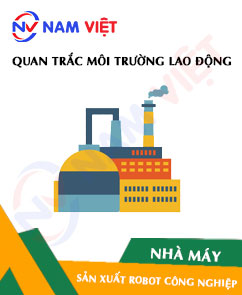
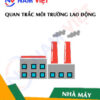
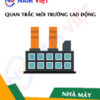
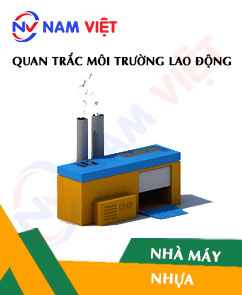

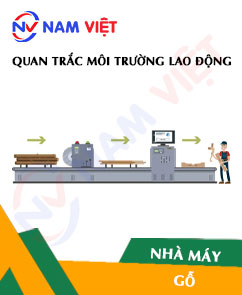





Review Occupational Environment Monitoring at the Industrial Robot Manufacturing Factory
There are no reviews yet.